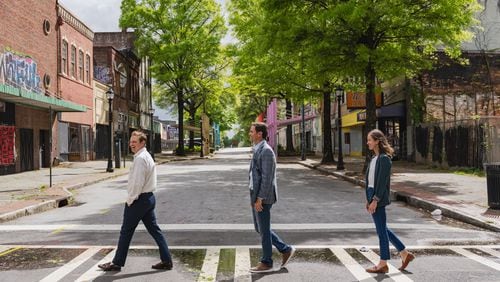ART REVIEW
“Masao Yamamoto and John Chiara”
Through Oct. 31. 10 a.m.-5 p.m. Tuesdays-Saturdays. Jackson Fine Art, 3115 E. Shadowlawn Ave., Atlanta. 404-233-3739, www.jacksonfineart.com.
Bottom line: Two photographers with an affinity for dreamy, artist-mediated visions of the world.
Life is enchanted when seen through photographer Masao Yamamoto’s lens. Homing in on his subjects with a poetic precision, this Japanese photographer takes the measure of the world around him: a forest grove illuminated by a ray of light suggesting something out of a fairy tale; a horizon that splits the landscape like a line on a chalkboard between sky and water; a solar eclipse; a piece of wood split down the center to reveal a rich interplay of striations and textures.
In the two bodies of work on display at Jackson Fine Art, "Kawa=Flow" and "Nakazora," Yamamoto works in dramatic gradations of black and white and sepia in delicate silver gelatin prints whose purposeful imperfections and aged appearance show evidence of the artist's hand. In these images, Yamamoto takes the world apart and puts it back together again, assembling something far more magical in the process.
The highlight of his show at Jackson Fine Art may be “Kawa=Flow #1637,” an uncanny image of a snow-white owl whose head is rotated away from us, creating a surreal portrait of a blank, featureless creature like something from a dream. “Kawa” is the Japanese word for river or stream, which Yamamoto takes as a metaphor for the flow of life depicted in his work.
Yamamoto’s images of animals are especially moving, often capturing them isolated in a vast expanse of space, underlining their fragility. A deer peers out from its protected perch in a hillside in “Nakazora #1165,” and in “Kawa=Flow #1642,” a monkey curled into a protective posture, its arms and legs pulled in close around itself, seems to float like a baby in utero, or a space traveler, in a field of white. By isolating his subjects, Yamamoto turns them into something closer to sculptures or paintings: unique, cherished things touched by the artist’s hand.
It’s not surprising that Yamamoto initially trained as a painter in his native Japan; the way he manipulates light, texture and effect in his images often feels more akin to a painter’s singular control of his materials.
Where so many contemporary photographers create large-scale prints, Yamamoto goes in the opposite direction, creating small, delicate images that give his subjects their jewel-like quality. The largest image is 8 by 10, and the majority are far smaller. You feel a sense of protectiveness for these solitary trees and forests, oceans and swans Yamamoto documents, because they are part of the fabric of the world we live in, captured in their most sublime forms.
The work becomes less compelling when Yamamoto turns to the male photographer’s chestnut, the female body. Those works can feel like a conventionalized vision of beauty compared to the unexpected, unusual vantages Yamamoto gives us in the majority of his works.
Yamamoto is paired up with San Francisco-based John Chiara, who also aims for a sort of simple poetry in his large-scale color photographs of the Mississippi landscape, in trees overtaken by kudzu and fields of golden grasses. The work often takes a common outsider’s view of the South as a verdant, overgrown jungle in which civilization is being reclaimed by encroaching nature.
Chiara creates his work in a fascinating process using an enormous homemade camera obscura, which he hauls on a flatbed truck out into the field, printing his one-of-a-kind images directly onto photo paper inside his enormous camera. The glossy landscapes that result feel haunted, like crime scenes, but it is his image of an American flag waving against the sky, “Sanderson at Corporation,” that may be his most arresting, its fragile, tentative state suggesting an ideal under siege.

/cloudfront-us-east-1.images.arcpublishing.com/ajc/P7DYBH6TO7FEKG4SUXQQKADRXE.jpg)



